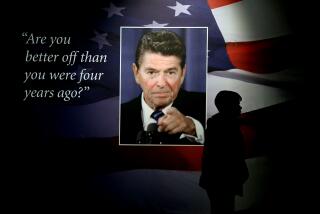Telling the Fiction From the Fact
- Share via
TARRYTOWN, N.Y. — “In Edmund Morris’ new biography of Ronald Reagan, the Pulitzer Prize-winning author uses a technique more in the spirit of ‘Forrest Gump’ than historical scholarship. Morris invents a narrator to help frame the former president’s life. And not just any narrator--a fellow named ‘Edmund Morris,’ a fictional contemporary of Reagan’s. So while the author was born nearly 30 years after his subject, he places himself alongside Reagan on the football field, the college campus and at the Army Air Force’s motion picture unit.”
--The Associated Press
News that Edmund Morris had reinvented himself as a fictional character and put himself into his biography of Ronald Reagan has provoked controversy among experienced fictional characters. From California to New York, in Dublin and Paris, in libraries, bookstores and bars, protagonists are debating Morris’ audacious move.
Rhett Butler of “Gone With the Wind” expressed the majority view. “Frankly, I’m concerned,” he said. “The line between history and fiction should be as firm as the Mason-Dixon line, and it’s a damn shame he crossed it.”
For other characters, the issue is more practical. “He ain’t got no right to take good jobs away from qualified fictional characters,” said Tom Joad. “‘Cept for a Bruce Springsteen song, I ain’t had steady work since Mr. Steinbeck put me in that ‘Grapes of Wrath,’ and that warn’t no picnic. I could do with a cushy gig like follerin’ Mr. Reagan’s life.”
Others argued whether Morris’ role as passive observer could be considered a character at all. “From what I understand, Edmund Morris the character doesn’t do much,” said Jean Valjean between bites of a corned beef sandwich (on a French roll) at a Broadway deli before a performance of “Les Miserables.” “He just watches Reagan and reports. I mean, mon dieu, if I were in the book, I’d be knee-deep in that Iran-Contra merde.”
His dining partner, Willy Loman, concurred, as he tried desperately to flag down a waiter. “Attention must be paid!” he exclaimed. “That Reagan,” he continued, “he was a fine figure of a man, an athlete, a Colossus. And well-liked. ‘Be liked and you will never want,’ that’s what I always say (twice on matinee days). Who is this Morris? A little weasel, barely a character, not like my strapping boys.”
In Europe, where such experiments in literature are more accepted, reaction was mixed, even within a single author’s oeuvre. Mr. Finnegan of James Joyce’s “Finnegan’s Wake” was clearly critical of Morris. “Ray-gun Morris president no precedent no morris more is Reagan more is,” he said. Another Joycean creation, Molly Bloom of “Ulysses,” gave Morris’ entry into fiction a resounding yes.
Others overseas were reluctant to weigh in on the topic. “Leave me out of it,” said Joseph K. from the courthouse in Prague where he was awaiting trial. “With my luck, if I say anything, I’ll be subpoenaed by Ken Starr, and I’ve had enough Kafkaesque experiences already, thank you very much.”
Reached at her home in England, Lady Chatterley declined to comment on the controversy but did admit that she had been approached about appearing in the authorized biography of President Bill Clinton.
More to Read
Sign up for our Book Club newsletter
Get the latest news, events and more from the Los Angeles Times Book Club, and help us get L.A. reading and talking.
You may occasionally receive promotional content from the Los Angeles Times.







